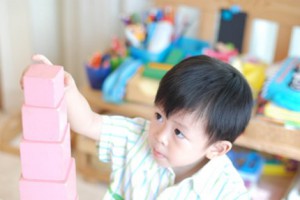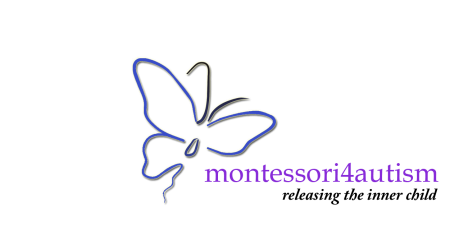Behavioral Foundation
Behavioral Foundation
Montessori’s approach and methods blend remarkably well with applied behavioral analysis (ABA), which is currently the only scientifically established method for treating children on the autistic spectrum.
- Parallels between Discrete Trials (DT) and Montessori Lessons
- Parallels between Montessori Curriculum and ABLLS
It is remarkable that Maria Montessori was using task analysis as early as the nineteenth century.
She borrowed and applied the idea of a “three-period lesson” from Edouard Seguin – an educator who founded a successful school for “deficients” in Paris in the mid-1800s.
The format of these lessons is very similar to a Discrete Trial (DT) in:
(a) sequence,
(b) its focus on teaching only one concept or quality at a time,
(c) using very simple language,
(d) breaking learning down into small manageable steps, and
(e) reducing distraction.
 Lessons are introduced with minimal speech (foregoing the lengthy explanations common in traditional schools) and emphasis on demonstration by the teacher. In structural terms, a lesson consists of 1) naming by the teacher (information), 2) recognition by the student (practice), and 3) naming by the student (test).
Lessons are introduced with minimal speech (foregoing the lengthy explanations common in traditional schools) and emphasis on demonstration by the teacher. In structural terms, a lesson consists of 1) naming by the teacher (information), 2) recognition by the student (practice), and 3) naming by the student (test).
In a Montessori classroom, appropriate tasks are carefully chosen and are introduced in sequential order to each child individually, with presentation tailored to the child’s strengths and weaknesses. The presentation of the tasks, Montessori Lesson, begins with identifying prerequisites necessary for successful accomplishment. Then each task is broken down into the various sub-skills, and the children practice one component at a time until they show mastery. The tasks are introduced by the teacher, with concise explanation and an emphasis on demonstration using attractive materials .
The Montessori curriculum is structured hierarchically to enable progress from simple to complex, and from concrete to abstract concepts in small sequential steps. This approach is close, if not identical, to the behavioral methods that have been identified as effective for teaching ASD children new and complex skills.
To ensure consistent skill acquisition, many ASD students follow ABLLS, which is an assessment, curriculum guide, and skills tracking system for children with autism and other developmental disabilities. ABLLS identifies prerequisite skills for acquisition of higher level skills and serves as an invaluable therapeutic and learning tool for these children. In a Montessori environment, all the tasks have built-in “control of error”, so that the child can receive immediate feedback as he works to solve the task at hand.
This way the child learns by doing with a maximum chance for success, rather than by being subjected to constant correction by the teacher. In this area, Montessori has an advantage over ABA, where both reinforcement or correction are mainly delivered by the therapist. To teach a wide variety of skills, the Montessori curriculum utilizes direct instruction and procedures such as reinforcement, extinction, shaping/modeling, prompting, fading, chaining, discrimination, and generalization, all of which are fundamental components of Applied Behavioral Analysis.
The Montessori curriculum also makes daily use of materials such as SRA Reading Comprehension (McGraw Hill), which is a staple in special education, as well as PECS (Picture Exchange Communication System), widely used with ASD students. Michelle Lane, founder of the Lane Montessori School for Autism, has written: “Having worked with ABA for many years and in autism for sixteen years, I feel that the Montessori curriculum is second to none. It appeals to the senses of the child but, more importantly, it is developmentally appropriate while maintaining a concrete and visual nature.” ¹
Please check out the thoughtful and comprehensive book “Montessori-Based Activities for Persons with Dementia“ Volume I and Volume II. It contains a series of programs for the elderly, but can be easily and successfully adapted to children with autism. Notably, the programs fully incorporate ABA principles, although not directly referring to them.
References
1. Lane, K. Michelle. A Montessori Approach to Autism. The NAMTA Journal. Spring 2009, p. 68
